Melrose Park, Illinois – Saturday, September 5th, 2009
 At first guess one might speculate that the closure of Chicago’s Kiddieland, the last remaining park from a long lineage of classic Chicago-area amusement parks with roots in the 1920’s, is just another story of a business being shuttered due to the economic downturn that will write the history books on this era of American history. Their long-time customer base simply don’t have any more disposable income to spend on non-necessities such as a day at an amusement park, and operating and maintenance expenses have become untenable. Picture a small community park rich in heritage but poor on funds to complete a much-needed update so they can remain viable with cleaner, safer looking properties such as the corporate Six Flags down the road.
At first guess one might speculate that the closure of Chicago’s Kiddieland, the last remaining park from a long lineage of classic Chicago-area amusement parks with roots in the 1920’s, is just another story of a business being shuttered due to the economic downturn that will write the history books on this era of American history. Their long-time customer base simply don’t have any more disposable income to spend on non-necessities such as a day at an amusement park, and operating and maintenance expenses have become untenable. Picture a small community park rich in heritage but poor on funds to complete a much-needed update so they can remain viable with cleaner, safer looking properties such as the corporate Six Flags down the road.
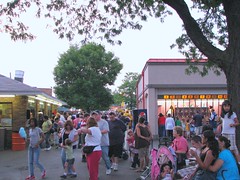 If you happened to be like me, an out-of-town first time visitor to the park late in the 2009 season, you’ll have realized that such a picture is wholly untrue. Kiddieland is not suffering from the economic downturn, business is booming. I arrived in the parking lot a little before 7:00 (later than I wanted since we got lost on the way in and instead of taking the Chicago Skyway we ended up driving down Michigan Avenue- great for the sights but not for expediency) to find a parking lot stuffed to the gills and crowds that would make Six Flags envious. There was still a line of people waiting to buy tickets to get into the park when it only had two hours left for the day. Tickets weren’t exactly cheap either, $20 for an evening ticket was borderline my threshold to pay for a place that only had one junior coaster and a small assortment
If you happened to be like me, an out-of-town first time visitor to the park late in the 2009 season, you’ll have realized that such a picture is wholly untrue. Kiddieland is not suffering from the economic downturn, business is booming. I arrived in the parking lot a little before 7:00 (later than I wanted since we got lost on the way in and instead of taking the Chicago Skyway we ended up driving down Michigan Avenue- great for the sights but not for expediency) to find a parking lot stuffed to the gills and crowds that would make Six Flags envious. There was still a line of people waiting to buy tickets to get into the park when it only had two hours left for the day. Tickets weren’t exactly cheap either, $20 for an evening ticket was borderline my threshold to pay for a place that only had one junior coaster and a small assortment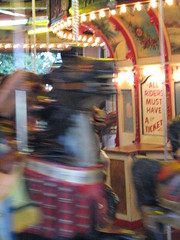 of other attractions adults are still capable of riding. Naturally a lot of these crowds stem from the announcement of its closure, I daresay Kiddieland has been seeing record attendance across the board this entire year, which also makes me somewhat cynically wonder if part of the reason for their closure is to capitalize on the nostalgia felt by everyone in the greater Chicago area.
of other attractions adults are still capable of riding. Naturally a lot of these crowds stem from the announcement of its closure, I daresay Kiddieland has been seeing record attendance across the board this entire year, which also makes me somewhat cynically wonder if part of the reason for their closure is to capitalize on the nostalgia felt by everyone in the greater Chicago area.
The official reason that Kiddieland is closing has less to do with finances and more to do with politics, at least inter-family politics. Apparently a faction of the family that owns the land wants to redevelop the site, which seems a bit strange that, A): it is members within the family that want to remove the park rather than some outside interest, and B): they think the land is more valuable for other uses. Again, maybe it’s just the fact that they’re experiencing a wave of nostalgia from people wanting to get one last visit in, but from what I saw the place appeared to be tremendously profitable, somewhat to my own chagrin since I realized that it would be difficult trying many rides in two hours with crowds as heavy as they were.
 It’s not just that the place was still popular, it’s also been maintained impeccably. Most of the rides were uniquely vintage (a Moser bounce tower and climbing playground were the only things I noticed on the original side of the park that were more modern installments) and fantastically preserved, the Little Dipper with a fresh coat of paint, smooth, clean blacktop lining most of the midways, and every scrap of chrome still shining like it was 1954. Honestly I was really bummed that this was all getting scrapped in a few weeks because it reminded me of a miniature Kennywood, with it’s almost Disney-esque cleanliness and flair in presenting an authentic slice of 1950’s Americana. Thankfully with everything in such fantastic condition I imagine there should be a considerable bidding war
It’s not just that the place was still popular, it’s also been maintained impeccably. Most of the rides were uniquely vintage (a Moser bounce tower and climbing playground were the only things I noticed on the original side of the park that were more modern installments) and fantastically preserved, the Little Dipper with a fresh coat of paint, smooth, clean blacktop lining most of the midways, and every scrap of chrome still shining like it was 1954. Honestly I was really bummed that this was all getting scrapped in a few weeks because it reminded me of a miniature Kennywood, with it’s almost Disney-esque cleanliness and flair in presenting an authentic slice of 1950’s Americana. Thankfully with everything in such fantastic condition I imagine there should be a considerable bidding war between other park operators wanting to nab these gems for themselves. According to this Chicago Tribune article, owner Tom Norini said he’s hoping to sell the entire park, including the famous entry sign, as one package to a park operator, and I really do hope that happens, at least with the original core of the park. Considering it works as a stand-alone park it would be a fantastic addition to any number of full-scale parks in the country. There was also talk that the family might relocate Kiddieland themselves to another suburb around Chicago. (Update: that obviously never happened)
between other park operators wanting to nab these gems for themselves. According to this Chicago Tribune article, owner Tom Norini said he’s hoping to sell the entire park, including the famous entry sign, as one package to a park operator, and I really do hope that happens, at least with the original core of the park. Considering it works as a stand-alone park it would be a fantastic addition to any number of full-scale parks in the country. There was also talk that the family might relocate Kiddieland themselves to another suburb around Chicago. (Update: that obviously never happened)
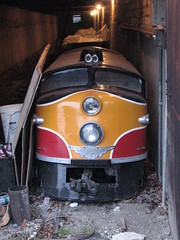 A tour of the park starts in the parking lot where the iconic Kiddieland sign sits at the corner, and also interestingly enough their miniature train set runs through as well. The front gates were pretty narrow and unassuming, but well staffed (all of Kiddieland had scores of young adult workers keeping the place clean and traffic flowing efficiently through the rides and stands, I also must wonder how many jobs are going to be lost for Melrose Park once Kiddieland is no longer part of the picture). The first attractions I came to on the left were the carousel and the train ride. My original plan had been to grab a ride on the train first before exploring the rest of the park on foot, but a very large line of families was already there so I had to skip it for the time being.
A tour of the park starts in the parking lot where the iconic Kiddieland sign sits at the corner, and also interestingly enough their miniature train set runs through as well. The front gates were pretty narrow and unassuming, but well staffed (all of Kiddieland had scores of young adult workers keeping the place clean and traffic flowing efficiently through the rides and stands, I also must wonder how many jobs are going to be lost for Melrose Park once Kiddieland is no longer part of the picture). The first attractions I came to on the left were the carousel and the train ride. My original plan had been to grab a ride on the train first before exploring the rest of the park on foot, but a very large line of families was already there so I had to skip it for the time being.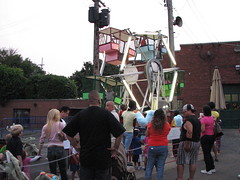 I continued straight past these to the park’s Elephant Ride and Mini Ferris Wheel… the gondolas were about 1/3 the height of the wheel itself, and not many people over the age of 12 would be likely to squeeze into one of those gondolas. In the far corner was the backstage train area, with one of the streamlined mini-diesel trains resting in storage, and the main train line running next to it through a very tight, claustrophobic tunnel. Even in this more downtrodden side of the park things were still somewhat high-class with plenty of brickwork and retro glass designs.
I continued straight past these to the park’s Elephant Ride and Mini Ferris Wheel… the gondolas were about 1/3 the height of the wheel itself, and not many people over the age of 12 would be likely to squeeze into one of those gondolas. In the far corner was the backstage train area, with one of the streamlined mini-diesel trains resting in storage, and the main train line running next to it through a very tight, claustrophobic tunnel. Even in this more downtrodden side of the park things were still somewhat high-class with plenty of brickwork and retro glass designs.
Turning towards the center of the park were more compact children’s flat rides, some covered like the automobiles, tubs and a Mangels Roto-Whip advertised as “brand new” and I would almost believe it looking at its condition. Along the Little Dipper were some more open-air spinning rides such as the Space Ships and Flying Saucers, again both extremely well preserved. The park is definitely a city park, with more concrete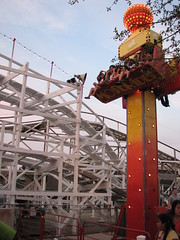 than grass lining the rides, but there are still several tall mature trees growing between attractions to offer a splash of greenery into the mis-en-scene, and it’s all so
than grass lining the rides, but there are still several tall mature trees growing between attractions to offer a splash of greenery into the mis-en-scene, and it’s all so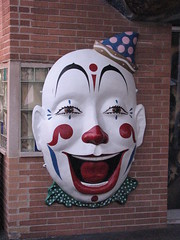 tightly packed together that the inclusion of traditional landscaping approaches would have been excess. Turning left into the far western reaches of the park behind the Little Dipper’s far turnaround were the aforementioned Moser tower and net playground given some volcanic theme, with a few more similarly interactive attractions further back but I didn’t bother to further investigate this small cul-de-sac. Instead I turned back along the Little Dipper’s course to it’s entryway to indulge in my first ride of the evening.
tightly packed together that the inclusion of traditional landscaping approaches would have been excess. Turning left into the far western reaches of the park behind the Little Dipper’s far turnaround were the aforementioned Moser tower and net playground given some volcanic theme, with a few more similarly interactive attractions further back but I didn’t bother to further investigate this small cul-de-sac. Instead I turned back along the Little Dipper’s course to it’s entryway to indulge in my first ride of the evening.
The wait for the Little Dipper filled the whole switchback section (there were only two wrapped along the front of the station) and spilled out through the middle of the food court plaza. The attention to detail here was quite good, from the gigantic (nightmarish?) clown face adorning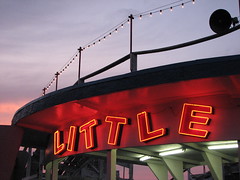 one of the brick walls to a vintage arcade room with an intricately painted cosmic awning, to a sign indicating condiments attached on a wall corner that featured a fully anthropomorphic hot dog sculpture anointing itself with ketchup. I cannot imagine I was the only one who wondered how much I’d have to pay for it at auction.
one of the brick walls to a vintage arcade room with an intricately painted cosmic awning, to a sign indicating condiments attached on a wall corner that featured a fully anthropomorphic hot dog sculpture anointing itself with ketchup. I cannot imagine I was the only one who wondered how much I’d have to pay for it at auction.
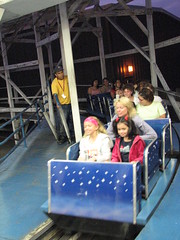 Twenty-eight minutes later I was sitting down to a front row ride on the Little Dipper, camera in hand. I’ll admit to saying that I brought a camera on the ride without explicit permission from the park. I was going to ask an operator before boarding but realized there was little point to it as I observed that every train load was being dispatched with no less than three video cameras filming either forward POV or taking snapshots of their families. Everyone at Kiddieland today had a camera, some quite heavy and expensive, even though I averaged nearly two photos a minute during my two hours at the park, I still somehow felt somewhat inadequate compared to several photographer pros who were snapping one off every couple seconds. Unfortunately I forget to adjust my settings to video until I was seated and didn’t have time to get it ready so I just had to take still photos on the auto-setting, which also resulted in most during the main part of the ride appearing way too blurry, although luckily the shots going up the lift looking into the sunset turned out nice.
Twenty-eight minutes later I was sitting down to a front row ride on the Little Dipper, camera in hand. I’ll admit to saying that I brought a camera on the ride without explicit permission from the park. I was going to ask an operator before boarding but realized there was little point to it as I observed that every train load was being dispatched with no less than three video cameras filming either forward POV or taking snapshots of their families. Everyone at Kiddieland today had a camera, some quite heavy and expensive, even though I averaged nearly two photos a minute during my two hours at the park, I still somehow felt somewhat inadequate compared to several photographer pros who were snapping one off every couple seconds. Unfortunately I forget to adjust my settings to video until I was seated and didn’t have time to get it ready so I just had to take still photos on the auto-setting, which also resulted in most during the main part of the ride appearing way too blurry, although luckily the shots going up the lift looking into the sunset turned out nice.
The ride still has the lever-operated skid-brakes in the station, and the four-car junior PTC train with buzzbars and single-bench seats kept loading times to a minimum even though the capacity was direly below the demand for the ride. As for the coaster itself, I can’t say too much since I was more focused on taking pictures than enjoying the ride, but it’s nothing too spectacular, which I suppose is good considering the park it’s located in. One of the construction kit models PTC released back in the late 40’s to 50’s, it starts with a small pre-drop off the lift that leads into the first full turnaround. The first drop is standard kiddie coaster, picking up a decent amount of speed that made me have to briefly hang on with one hand while my other was on the camera while on the pullout. Up the next elevated turn with traces the track below in the station, it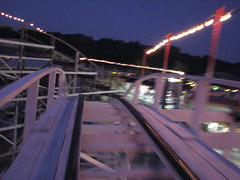 dives down a bit again into a small, mostly airless bunny hop before cruising up and around the final turn buried in the supports beneath the first one off the lift. There’s another little dip, hardly noticeable in fact, and the train slides into the skid brakes hardly thirty seconds after it disengaged the lift. It’s a classic and people love it, heck I loved it, but regarding it as an actual coaster experience there’s almost nothing there. Perfect for the demographics of the park because it still has the presentation of a real, full-scale wooden coaster without much of intensity, so that way the six-and-under crowd can feel like they’ve accomplished something important without much real chance that they could become scared off of coasters later if it does prove too intense.
dives down a bit again into a small, mostly airless bunny hop before cruising up and around the final turn buried in the supports beneath the first one off the lift. There’s another little dip, hardly noticeable in fact, and the train slides into the skid brakes hardly thirty seconds after it disengaged the lift. It’s a classic and people love it, heck I loved it, but regarding it as an actual coaster experience there’s almost nothing there. Perfect for the demographics of the park because it still has the presentation of a real, full-scale wooden coaster without much of intensity, so that way the six-and-under crowd can feel like they’ve accomplished something important without much real chance that they could become scared off of coasters later if it does prove too intense.
 Disembarking from my Little Dipper experience I continued straight east back towards the entrance, contemplating a ride on the Tilt-a-Whirl (the first adult flat ride I came across) before being drawn to the astoundingly elegant
Disembarking from my Little Dipper experience I continued straight east back towards the entrance, contemplating a ride on the Tilt-a-Whirl (the first adult flat ride I came across) before being drawn to the astoundingly elegant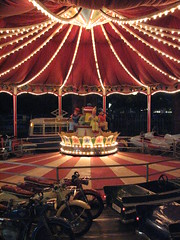 German Carousel across from the entrance that acts as a companion piece to the main carousel for those that enter the park going right instead of straight as I had. At first glance it looked like a larger version of the standard motorcycle ride, but then I noticed that every set of vehicles was something completely different… convertibles, scooters, hot rods, a trolley, space ships, bicycles… all with working lights and individually detailed to the nth degree. Even the housing itself would put many an antique carousel to shame with the lighting package and murals adorning the roof. The fact that I was more than a decade too late in getting here hardly detoured me from wanting to take a ride. Except for I would look incredibly stupid, and, perhaps more importantly, I couldn’t choose just one thing I wanted to ride.
German Carousel across from the entrance that acts as a companion piece to the main carousel for those that enter the park going right instead of straight as I had. At first glance it looked like a larger version of the standard motorcycle ride, but then I noticed that every set of vehicles was something completely different… convertibles, scooters, hot rods, a trolley, space ships, bicycles… all with working lights and individually detailed to the nth degree. Even the housing itself would put many an antique carousel to shame with the lighting package and murals adorning the roof. The fact that I was more than a decade too late in getting here hardly detoured me from wanting to take a ride. Except for I would look incredibly stupid, and, perhaps more importantly, I couldn’t choose just one thing I wanted to ride.
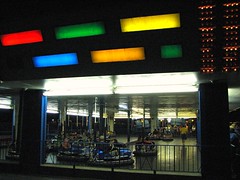 Turning back northward up the main midway are where a lot of the newer adult flat rides are located (“adult” being a relative term at Kiddieland, more closely meaning people over 12 aren’t excluded from riding) I passed by the Scooter bumper cars on the right and administrative buildings on the left (did I mention that they serve free, unlimited soft drinks here as well? You get smaller Styrofoam cups,
Turning back northward up the main midway are where a lot of the newer adult flat rides are located (“adult” being a relative term at Kiddieland, more closely meaning people over 12 aren’t excluded from riding) I passed by the Scooter bumper cars on the right and administrative buildings on the left (did I mention that they serve free, unlimited soft drinks here as well? You get smaller Styrofoam cups,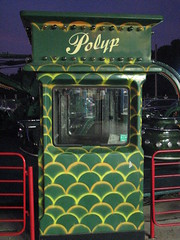 but still, they’re one of only four parks in the nation to offer that promotion). This part lacks some of the same charm found in the original core of the park, being slightly more spread-out and with larger patches of empty concrete forming a straight-forward walkway rather than the labyrinth of kiddie rides seen earlier. At the end of this pathway before the railway crossing was the Polyp, dark from inactivity. Although I was disappointed to see it down because it was probably the second-most ride I was anticipating after the Little Dipper, I wasn’t surprised because I think in every park report I’ve ever read the Polyp was down. I’m not 100% positive what it does, it has the appearance of some sort of Calypso mixed with an Eyerly Monster, although honestly the only bigger mystery to me than how the ride program works is where it got its name (maybe ‘polyp’ means something else in German?). Hopefully this one finds a new home somewhere and I can visit when it’s fixed and working.
but still, they’re one of only four parks in the nation to offer that promotion). This part lacks some of the same charm found in the original core of the park, being slightly more spread-out and with larger patches of empty concrete forming a straight-forward walkway rather than the labyrinth of kiddie rides seen earlier. At the end of this pathway before the railway crossing was the Polyp, dark from inactivity. Although I was disappointed to see it down because it was probably the second-most ride I was anticipating after the Little Dipper, I wasn’t surprised because I think in every park report I’ve ever read the Polyp was down. I’m not 100% positive what it does, it has the appearance of some sort of Calypso mixed with an Eyerly Monster, although honestly the only bigger mystery to me than how the ride program works is where it got its name (maybe ‘polyp’ means something else in German?). Hopefully this one finds a new home somewhere and I can visit when it’s fixed and working.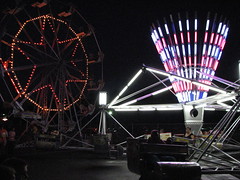
After letting a train pass, on the other side of the tracks is an oddly schizophrenic part of the park. On the right is an Eli Bridge Scrambler and Ferris Wheel, a Zamperla Galleon and a Wisdom Tornado all planted over what appeared to be used parking lot which gave it a distinctly tacky carnival feel. On the left, however, were the Antique Car ride, Log Flume and Hydrocoaster, all hidden behind groves full trees and with great landscaping and themed detailing, each belonging to a very different park on the exact same midway. The Log Flume looked especially nice so I joined the line for that one, which thankfully zipped by in not much more than ten minutes. The station has a great rustic feel to it, nothing more elaborate than what would be found at a larger regional park (albeit one that cares), but perhaps heightened by the use of all-yellow lighting that gave it an off-balance glow. There’s a long ground-level trough that runs past the landscaping and features a few moments of almost-rapids, before slowing down a bit on a circular stretch past a lagoon. Since it was already completely dark out when I rode parts of it were completely bathed in blackness. The conveyor lift is probably the tallest thing in the park, closely tied with the Hydrocoaster next door, and there’s a quick right turn at the top before it sets up for the plunge back down into a secondary splashdown lagoon. A bit of a spray, but not much, thankfully, given it was after dark on a September weekend. Besides the Little Dipper this is likely Kiddieland’s signature attraction, and the quality surpasses many other larger parks flume rides.
nice so I joined the line for that one, which thankfully zipped by in not much more than ten minutes. The station has a great rustic feel to it, nothing more elaborate than what would be found at a larger regional park (albeit one that cares), but perhaps heightened by the use of all-yellow lighting that gave it an off-balance glow. There’s a long ground-level trough that runs past the landscaping and features a few moments of almost-rapids, before slowing down a bit on a circular stretch past a lagoon. Since it was already completely dark out when I rode parts of it were completely bathed in blackness. The conveyor lift is probably the tallest thing in the park, closely tied with the Hydrocoaster next door, and there’s a quick right turn at the top before it sets up for the plunge back down into a secondary splashdown lagoon. A bit of a spray, but not much, thankfully, given it was after dark on a September weekend. Besides the Little Dipper this is likely Kiddieland’s signature attraction, and the quality surpasses many other larger parks flume rides.
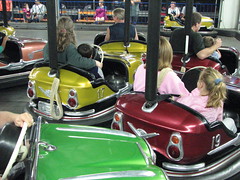 I contemplated giving the Pipeline Hydrocoaster a try next but it appeared the same as the version at Michigan’s Adventure and I didn’t have a good place to store the camera, so I moved back toward the front to try the Scooter bumper cars. The wait lasted some fifteen minutes, longer than it needed to because the load time seemed to take an eternity to sort everyone out into the cars and explain the seatbelt procedure to those short enough needing one. The cars looked like mini-Lusses but the plates on them indicate they’re from a company called Hot Rods, who I am not sure if they have any other installations in the country. I’d rather stick to the Lusse, however, since these cars didn’t run particularly strong, and the cycle was the shortest I’ve ever had on a bumper car, lasting not much more than a minute
I contemplated giving the Pipeline Hydrocoaster a try next but it appeared the same as the version at Michigan’s Adventure and I didn’t have a good place to store the camera, so I moved back toward the front to try the Scooter bumper cars. The wait lasted some fifteen minutes, longer than it needed to because the load time seemed to take an eternity to sort everyone out into the cars and explain the seatbelt procedure to those short enough needing one. The cars looked like mini-Lusses but the plates on them indicate they’re from a company called Hot Rods, who I am not sure if they have any other installations in the country. I’d rather stick to the Lusse, however, since these cars didn’t run particularly strong, and the cycle was the shortest I’ve ever had on a bumper car, lasting not much more than a minute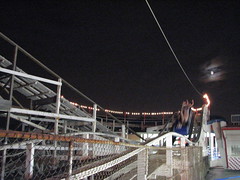 before they had to stop us to get the next batch of people through. I had about a half-hour until 9:00 so I decided to get one more ride in on the Little Dipper. The queue was about the same as last time, twenty-eight minutes long, leaving me with not much opportunity to do anything else. At least I was able to get a full POV video on this second ride from the back row, which is posted at the end of this article.
before they had to stop us to get the next batch of people through. I had about a half-hour until 9:00 so I decided to get one more ride in on the Little Dipper. The queue was about the same as last time, twenty-eight minutes long, leaving me with not much opportunity to do anything else. At least I was able to get a full POV video on this second ride from the back row, which is posted at the end of this article.
With my two minutes left before parking closing, I rushed to the train to see if I couldn’t get one of the last rides of the night. A park attendant was standing by the entrance already turning people away. I thought I remembered seeing still a full line-up for the Little Dipper when I got off, so I went back there to find the last person in line was another attendant. Before walking out the gates I felt I needed to get at least one more ride in somewhere to get my full $20 admission’s worth, and found the Carousel was still accepting new riders. I’ve not been on a carousel in ages, so I figured what the heck. It’s a nice carousel for families, a PTC design added in 1925. However, it’s a little small and a little slow, and most of the horses looked like they could use a restoration, so it probably wasn’t my best introduction back into the world of menageries and calliopes, but it’s good for the park and was a peaceful, somewhat sleepy way to end the evening.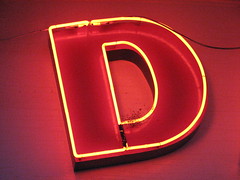
Overall I had a good time at Kiddieland despite the crowds; most of the rides were so small anyway that not getting as many rides in as I would have liked was a fair trade-off for the added energy from the crowds and chances to people-watch a diverse Chicago population. I really hope they either relocate or find a park willing to buy them whole (I kind of doubt it would remain in Chicago in the second case since that doesn’t strike me as anything Six Flags Great America would be likely to do despite their new-found focus on families). If it does become part of a larger park I think someplace like Iowa’s Adventureland or one of the traditional east coast parks such as Seabreeze, Lake Compounce or maybe even Knoebels would find tremendous use of it (or maybe they could team up with the also-evicted Bell’s Park and find a place to lay down new roots together). However I rather think they’d be better off remaining independent and relocating somewhere else in the Chicago area. Chicagoans certainly would appreciate not seeing their tradition shipped off somewhere else, just evidenced by the number of people taking photos of the Kiddieland sign upon leaving, and Six Flags simply can’t be left as the only park servicing an region as large and historically diverse as Chicago. Regardless of the outcome, I am extremely confident that even if the institution of “Kiddieland” is disbanded, the individual attractions will nearly all rise up somewhere else in the country someday. I hope that day happens soon.
despite their new-found focus on families). If it does become part of a larger park I think someplace like Iowa’s Adventureland or one of the traditional east coast parks such as Seabreeze, Lake Compounce or maybe even Knoebels would find tremendous use of it (or maybe they could team up with the also-evicted Bell’s Park and find a place to lay down new roots together). However I rather think they’d be better off remaining independent and relocating somewhere else in the Chicago area. Chicagoans certainly would appreciate not seeing their tradition shipped off somewhere else, just evidenced by the number of people taking photos of the Kiddieland sign upon leaving, and Six Flags simply can’t be left as the only park servicing an region as large and historically diverse as Chicago. Regardless of the outcome, I am extremely confident that even if the institution of “Kiddieland” is disbanded, the individual attractions will nearly all rise up somewhere else in the country someday. I hope that day happens soon.
Comments